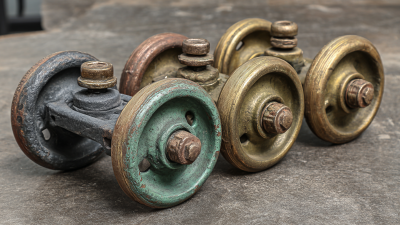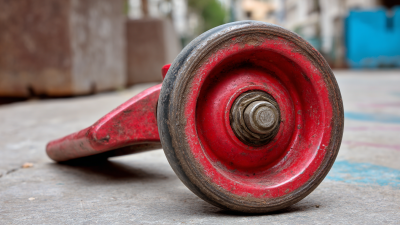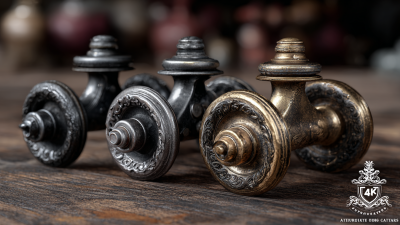
Revamping Vintage Furniture with Antique Metal Casters for Modern Living
In the world of interior design, the fusion of old and new has become increasingly popular, particularly in the realm of vintage furniture renovation. One of the most captivating ways to breathe new life into classic pieces is by incorporating Antique Metal Casters, which not only enhance mobility but also add a distinctive aesthetic charm. Renowned designer and vintage furniture expert, Jonathan Pierce, once said, "The true beauty of vintage design is how it can adapt and thrive in modern spaces with the right accents."

Antique Metal Casters serve as the perfect accent, bridging the gap between antiquity and contemporary living. They provide a practical function while celebrating the craftsmanship of the past, transforming static furniture into dynamic pieces that can flow seamlessly within a modern home. As homeowners seek to curate environments that reflect their individuality, the integration of such elements becomes key to creating a personalized narrative.
In this exploration of revamping vintage furniture, we will delve into the various styles of Antique Metal Casters and the innovative techniques that can be employed to elevate classic designs. Through thoughtful selection and application, these charming components can significantly enhance both the functionality and aesthetic appeal of vintage furnishings, making them suitable for today's lifestyle while honoring their storied heritage.
Choosing the Right Antique Metal Casters for Your Vintage Furniture
When it comes to revamping vintage furniture, the choice of antique metal casters can significantly enhance both functionality and aesthetics. According to recent studies by the Home Improvement Research Institute, 60% of homeowners are looking to incorporate vintage pieces into their modern living spaces, highlighting the demand for unique, stylish options that blend with contemporary decor.
Choosing the right antique metal casters not only updates the functionality of your vintage items but also preserves their charm and character.
When selecting casters, consider materials such as brass and wrought iron, which have witnessed a resurgence among designers and homeowners alike. Reports from the National Furniture Association indicate that brass casters are particularly popular for their durability and timeless appeal, making them ideal for high-traffic areas. Furthermore, the right size and style of casters can make a dramatic difference; oversized or decorative casters can become a statement feature, while smaller, more understated options may provide a subtler touch that complements vintage aesthetics without overwhelming them.
Essential Tools for Successfully Revamping Vintage Furniture
Revamping vintage furniture can breathe new life into cherished pieces, especially when incorporating antique metal casters. These charming wheels not only enhance mobility but also add a distinctive touch that blends the old with the new. To achieve a successful transformation, it's essential to equip yourself with the right tools.
First and foremost, a quality screwdriver set is indispensable. Different types of screws are often used in vintage furniture, and having the right screwdriver will make disassembly and reassembly much smoother. Additionally, a wood glue or epoxy is crucial for reinforcing joints that may have weakened over time. When it comes to refinishing surfaces, consider using sandpaper of varying grit levels to ensure a smooth and polished finish.
**Tips:** When attaching new casters, make sure to measure the height of your furniture first to maintain desired proportions. Additionally, choose casters that complement the overall aesthetic of the piece—antique brass for a traditional look or sleek black for a modern twist can make a significant difference. Finally, always remember to pre-drill holes for the screws; this prevents the wood from splintering and guarantees a sturdier fit.
Step-by-Step Guide to Installing Antique Metal Casters
Revamping vintage furniture with antique metal casters not only adds a touch of elegance but also enhances functionality, allowing for easy mobility in modern living spaces. To install these charming additions, you'll want to follow a precise step-by-step process. Begin by gathering your materials: antique metal casters, a screwdriver, measuring tape, and a drill. Carefully measure and mark where the casters will be attached on each leg of the furniture piece.
When you're ready to install, it's important to prepare the legs of the furniture. Remove any old casters or remnants to ensure a flat surface. Use the drill to create small pilot holes for the screws. This step will prevent the wood from splitting during installation. Position the antique casters in the marked spots, aligning them correctly with the pilot holes. Secure them firmly with screws using a screwdriver to ensure stability.
Tips: Always choose casters that can support the weight of the furniture, as inadequate support can lead to damage. Additionally, consider selecting casters with a locking mechanism if you want to ensure the furniture remains stationary when needed. Lastly, maintain the antique finish of the casters by regularly polishing them with a soft cloth to prevent tarnishing, preserving their vintage charm while enhancing your modern decor.
Creative Ideas for Styling Vintage Furniture with Modern Aesthetics
Revamping vintage furniture with antique metal casters offers a unique blend of nostalgia and modern aesthetics. This approach not only enhances the usability of classic pieces but also injects a contemporary flair that can harmonize with various interior styles. By incorporating midcentury modern elements, such as sleek lines and low profiles, designers can create a seamless fusion of old and new. For instance, pairing a vintage dresser with industrial metal casters allows for mobility, making it easy to reposition in a modern space while retaining its historical charm.
Incorporating eclectic touches through color and texture can further elevate the style of vintage furniture. Opting for bold paint choices or contemporary patterns can juxtapose beautifully against antique wood finishes, creating a striking visual appeal. Additionally, layering these vintage pieces with modern accessories, like abstract artworks or minimalist lighting fixtures, can enhance their presence in a room. This curation not only celebrates the beauty of vintage designs but also caters to a modern audience seeking both functionality and aesthetic value in their living environments.
Revamping Vintage Furniture with Antique Metal Casters for Modern Living
| Furniture Type | Vintage Style | Caster Material | Color Scheme | Modern Aesthetic | Usage Scenario |
|---|---|---|---|---|---|
| Coffee Table | Mid-Century Modern | Brass | Neutral Tones | Minimalist | Living Room |
| Dining Chair | Industrial | Steel | Bold Black | Eclectic | Dining Room |
| Writing Desk | Victorian | Iron | Pastel Colors | Contemporary | Home Office |
| Bookshelf | Art Deco | Chrome | White and Gold | Stylish | Reading Nook |
Maintenance Tips to Keep Antique Casters in Perfect Condition
Maintaining antique metal casters is essential for preserving the charm and functionality of vintage furniture in modern living spaces. Regular cleaning is the first step in keeping them in good condition. Use a soft cloth to remove dust and debris, ensuring that no abrasive materials come into contact with the metal. For deeper cleaning, a mixture of mild soap and water can be used; however, it's crucial to dry them thoroughly afterward to prevent rust formation.
Lubrication plays a key role in maintaining the movement and integrity of antique casters. A few drops of machine oil or silicone spray can help reduce friction and ensure smooth rolling. It’s best to apply the lubricant directly to the axle of the caster, allowing it to penetrate. Additionally, periodically inspecting the casters for any signs of wear or damage will help catch potential issues early, ensuring that these charming pieces continue to complement your home for years to come.
Related Posts
-

Unmatched Quality in Global Export of Vintage Metal Caster Wheels Made in China
-

10 Reasons Why Best Vintage Steel Casters are Essential for Your Business Success
-

Innovative Solutions for Cast Iron Caster Applications
-

Unlocking the Technical Specifications of the Best Globe Caster for Global Buyers
-

5 Essential Tips for Choosing the Right Caster Swivel for Your Business Needs
-

The Ultimate Guide to Sourcing the Best Antique Metal Casters for Your Projects
